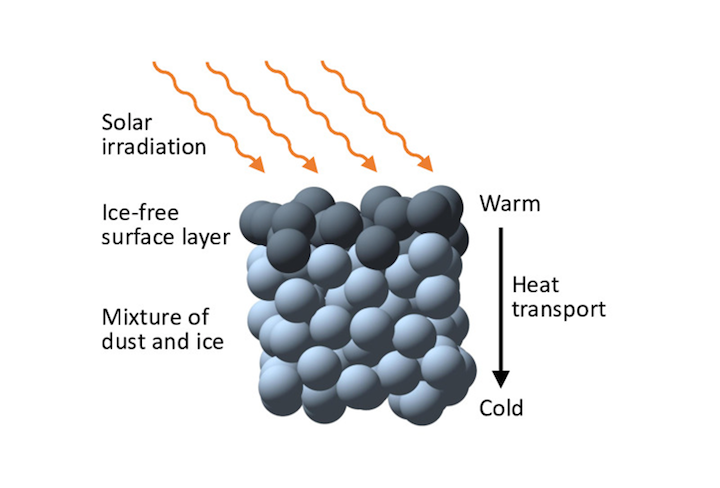26.10.2017

Schematic representation of the porous surface structure of comet 67P/Churyumov-Gerasimenko. Based on the results of the Rosetta mission, Blum and colleagues conclude that comet 67P is composed of millimetre-sized dust pebbles. It is assumed that the pebbles inside the comet consist of a mixture of dust and ice (light blue spheres in the image) and only the uppermost layers, which are exposed to direct sunlight, do not contain ice (dark grey spheres). Credit: Maya Krause, TU Braunschweig.
-
The missing link in our understanding of planet formation has been revealed by the first ever spacecraft to orbit and land on a comet, say German scientists. The study is published in a recent edition of the journal Monthly Notices of the Royal Astronomical Society.
A research team led by Jürgen Blum (Technische Universität Braunschweig, Germany) have analysed data from the historic Rosetta mission to uncover how comet 67P/Churyumov-Gerasimenko, or "Chury" for short, came into existence more than four and a half billion years ago.
Understanding the evolution of our solar system and its planets was one of the main objectives of the Rosetta mission to comet 67P/Churyumov-Gerasimenko. For Jürgen Blum and his international team it was worth it, because results from the various Rosetta and Philae instruments have revealed that only one out of many proposed models can explain their observations. Comet 67P consists of 'dust pebbles' ranging between millimetres and centimetres in size.
Professor Blum explains the implications of the team's observations "Our results show that only a single model for the formation of larger solid bodies in the young solar system may be considered for Chury. According to this formation model, 'dust pebbles' are concentrated so strongly by an instability in the solar nebula that their joint gravitational force ultimately leads to a collapse."
This process forms the missing link between the well-established formation of 'dust pebbles' ('planetary building blocks' formed in the solar nebula by sticking collisions between dust and ice particles) and the gravitational accretion of planetesimals into planets, which scientists have pondered over for years.
"Although it sounds very dramatic" Blum continues, "it's actually a gentle process in which the dust agglomerates are not destroyed, but are combined into a larger body with an even greater gravitational attraction - the accumulation of the dust agglomerates into a coherent body is virtually the birth of the comet." Due to the relatively small mass of comet 67P, the pebbles survived intact until today, allowing scientists to confirm the hypothesis for the first time.
In fact, the pebble-collapse formation model can explain many observed properties of comet 67P, for instance its high porosity and how much gas is escaping from inside. "Now all phases in the planet-formation model have been established", concludes Blum.
Quelle: Royal Astronomical Society.
